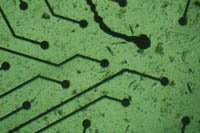Jon Bird at Sussex and co-organiser of
Blip, a Brighton based forum for creative art, science and technology has been working with Andy Webster at Falmouth, on a project entitled
Tuning Pask's Ear, inspired by an experiment conducted by Gordon Pask in the late 1950's training growing metal dentrites to recognise sounds. The original experiment is documented by Peter Cariani "
To evolve an ear:epistemological implications of Gordon Pask's electrochemical devices"Below are images and short statements of their current ongoing experiments with electrochemical deposition.
Jon BirdJon is interested in systems that exhibit evolutionary and learned behaviour. He is working on a micro scale, re-appropriating devices used in bio-technology to grow metal filaments. The devices and associated control equipment enable the programming of many inputs and outputs, once a few teething problems with their unusual use have been ironed out.


Electrodes which are about 200 microns apart in copper sulphate solution. After 5 minutes growth can be seen along all of track rather than just at the electrode (due to erroneous disolving of bio varnish)
Andy Webster
Andy works at the other end of the scale, on a macro level, relating to sculptural and conceptual art:
"I have been making work that re-reads Richard Serra's early experimental work generated by a verb-list, and blend this with thinking found in Manuel Delanda's writing about intensive properties.
Whereas Serra performed a series of specified actions on unspecified materials prompted by: to fold, to roll, to disperse, to stack etc., I have been trying to tap into the inherent capacity of matter and energies to self-organise, to find their own structure etc. and use this as a means to explore Serra's verb-list.
This is where the electrochemistry comes in as it can be seen to autonmously stack
metallic particles, thus producing a series of stacking / clustering pieces.
I have been using solar energy and specified durations to frame/structure the work. My interest lies in how thread structures have the potential to work as real-time artworks, directly
linked and responsive to their environment, with the resulting form, shaped by the history of those environmental interactions, rather than the artists actions, as in Serra's case."
 Solar Clusterings (1)
Solar Clusterings (1) Solar Clusterings (2)
Solar Clusterings (2) Stacking Hedge
Stacking Hedge




 Electrodes which are about 200 microns apart in copper sulphate solution. After 5 minutes growth can be seen along all of track rather than just at the electrode (due to erroneous disolving of bio varnish)
Electrodes which are about 200 microns apart in copper sulphate solution. After 5 minutes growth can be seen along all of track rather than just at the electrode (due to erroneous disolving of bio varnish) Solar Clusterings (1)
Solar Clusterings (1) Solar Clusterings (2)
Solar Clusterings (2) Stacking Hedge
Stacking Hedge